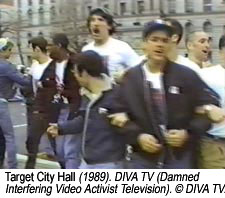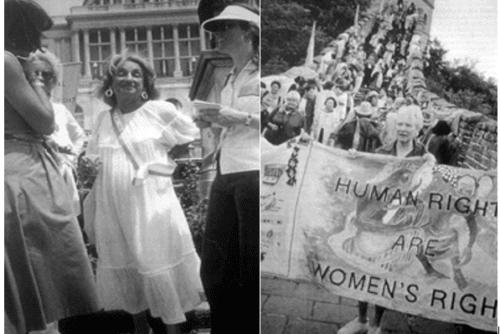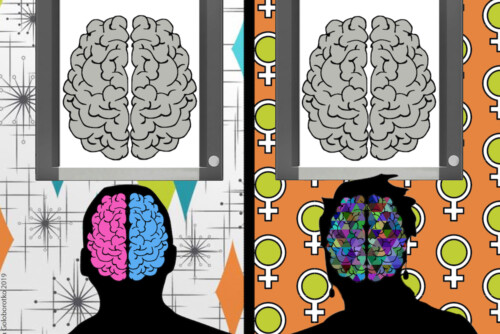Collective Memory and the Archived Witness
We should not, however, dismiss the militancy inscribed in many of the videos as a matter confined to history. In light of what she calls the contemporary “gentrification of the mind,” lesbian writer Sarah Schulman argues for the historically redemptive value of that militancy:
I would say, that in this horrible selfish, dishonest, “private” social moment, the kind of “activism” based on an ethic that people are responsible for how others act and how they are treated is pretty much impossible. . .. I’m glad I witnessed the gorgeousness of ACT UP so that I know that it is right and possible to intervene on behalf of others. But I don’t expect to see a moment like that right now. The status quo on AIDS is a consequence of this moment. It will change and this change requires a different counter-culture of personal values. I believe that it will come, and talking about it is part of making it possible – even if the timeline of change is a long one. (Schulman, my emphasis)
Schulman is part of a generation of lesbians and gay men who maintain a paradoxical relation to the late 1980s and early 1990s. On the one hand, it is a painful period filled with so many deaths, but on the other hand, it is also a time of collective intervention and mutual responsibility, this “gorgeousness of ACT UP” that Schulman recalls. She thus stresses the redemptive necessity in sustaining the memory of that time and culture.

The nostalgia for the mutuality embodied by ACT UP and its culture is not restricted to the generations who participated in it. At a recent symposium marking 20 years of the AIDS pandemic, I heard a gay man in his early twenties explain his deep sense of nostalgia for the culture of ACT UP, an experience he missed by a generation. His comments characterize a feeling amongst many young gay men of alienation towards the normalized and commodified gay culture in which they have come out. The mutuality and activism of the ACT UP era thus serves as a powerful popular memory for them. In light of this, alternative AIDS media from this period provide an invaluable tool for such a politics of memory, bearing witness to this cultural and political moment and all its redemptive potentialities. As the testimonial practices of Holocaust memory continue to demonstrate more than 50 years after the event, the address inscribed in the act of bearing witness may carry across time, and even become stronger with time. It is in this context that our understanding of bearing witness may draw from two particular meanings of the verb “to bear”: to sustain and to carry in thought or memory.
Sustaining a collective gay memory of the trauma of AIDS poses a specific challenge that differentiates it from other collective traumas that have produced extensive testimonial practices, such as the Holocaust and Hiroshima-Nagasaki. Jewish collective memory of the Shoah, for instance, has been significantly grounded in the initial familial transfer of memory to “second generation witnesses” (Hartman). Sons and daughters of survivors grew up in families where the trauma of the Holocaust was still very present, either consciously through testimonial practices or unconsciously through traumatic repetition and transference. Marianne Hirsch has proposed the notion of “postmemory” to describe the psychological specificities of such “passing on”:
Postmemory most specifically describes the relationship of children of survivors of cultural or collective trauma to the experiences of their parents, experiences that they “remember” only as the narratives and images with which they grew up, but that are so powerful, so monumental, as to constitute memories in their own right. (9)
While lesbians and gay men have developed alternative structures of familial and affective bonds, it is precisely these bonds which have been so endangered by the AIDS epidemic. Generational transference of collective memory and structures of feeling necessarily occurs later in the adult lives of lesbians and gay men, rather than during childhood within the structure of the biological family, as is the case with ethnic communities and groups.
Therefore the preservation of cultural practices and the objects they produce, such as films and videos, becomes all the more important for sustaining lesbian and gay collective memory. Communicating the magnitude of the AIDS epidemic to future generations of lesbians and gay men cannot be left only to the material archive of dominant AIDS representation, for it risks replicating the objectification and pathology which such representation originally produced. That material archive of representation will survive because of the institutional hegemony that produced it. It will probably also come to be profoundly useful for future film- and videomakers in a similar way that the material archive of heteronormative postwar U.S. culture has proved so conducive to appropriation by many queer and feminist filmmakers. But the preservation of the material archive of alternative AIDS media will always be a more significant issue for lesbians and gay men since we cannot assume that any public or private institution will necessarily take on such a responsibility.
The efforts of the Estate Project, DIVA TV, and other organizations to preserve the work of alternative AIDS media thus appear all the more requisite. The challenge for this work of preservation will be to sustain the address of these films and videos in the present and not just for the future. The decision to place the Royal S. Marks Collection in the New York Public Library with public access to most of the works reflects an important effort to face this challenge. Similarly, James Wentzy’s placement of downloadable AIDS activist videos on the DIVA TV website marks a promising development in maintaining access to this material archive, in sustaining the address of the works within it. The Internet may in fact come to be a vital resource for continuing the work of bearing witness to the AIDS epidemic through this material archive. Additionally, we should not forget that continuing to write about and discuss these films and videos is equally important. If the history of film studies as a discipline can teach us anything about the archive and the preservation of memory, it is that works produced on the margins need people to continue to discuss them if they are to survive, both intellectually and materially. I have come to see my own research within the framework of such an endeavor – to sustain the address of these films and videos, to bear witness to it by carrying it forward in thought and memory.
Works Cited
Atkins, Robert. “Symposium: The Unfashionability of AIDS,” in Artery: The AIDS Arts Forum, available at http://www.artistswithaids.org/artery/symposium/symposium_motion.html.
Bordowitz, Gregg. “Guest List for a Cocktail Party.” Camerawork 25.1 (1998): 4-9.
Crimp, Douglas. Melancholia and Moralism: Essays on AIDS and Queer Politics. Cambridge, Mass.: The MIT Press, 2002.
Hartman, Geoffrey. The Longest Shadow: In the Aftermath of the Holocaust. Bloomington: Indiana UP, 1996.
Hirsch, Marianne. “Surviving Images: Holocaust Photographs and the Work of Postmemory,” Yale Journal of Criticism 14.1 (2001): 5-37.
Román, David. “Not-About-AIDS.” GLQ 6.1 (2000): 1-28.
Rosenberg, Tina. “How to Solve the World’s AIDS Crisis,” New York Times Magazine, 28 January 2001: 26-31, 52, 58-63.
Schulman, Sarah. “Symposium: Gentrification of the Mind,” available at http://www.artistswithaids.org/artery/symposium/symposium_schulman.html.
Sullivan, Andrew. “When Plagues End: Notes on the Twilight of an Epidemic,” New York Times Magazine, 10 November 1996: 52-62, 76-77, 84.



